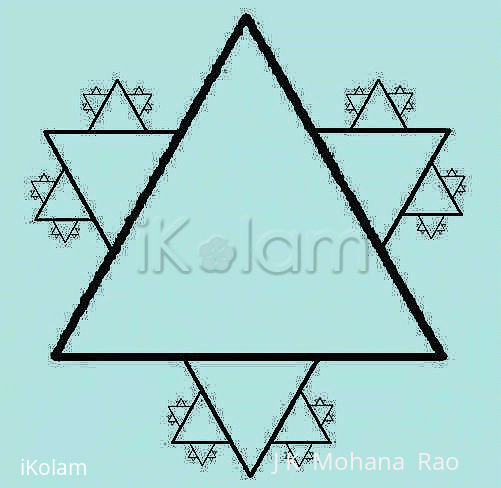Star of David - Fractal :-)
About Star of David - Fractal :-) : PRINT
This is a modified version of the Star of David.
Occupying one third of the side of each equilateral
triangle, add another triangle of one-third side
length in the middle of each side. If one goes on
doing this infinitely, one gets a fractal Star of
David! Mathematicians call these type of curves
Peano curves. Even though the operation is carried
out infinitely, the area of the curve is finite. I
did this entirely on the computer, not with hand.
That is why the thickness of lines is different.
Please bear with me for that. Enjoy and comment!
Regards! - mOhana




Comments
Lata
Mon, 2008-12-22 13:20
Permalink
mOhanaji, this reminds me of Koch's curve that we learnt in math class. I think the koch's curve starts off as a line segment, gets divided into 3 thirds and the middle part is drawn like a triangle (without base), and it keeps going...
I was hoping someone over the course of time would introduce the mathematical aspects of Kolams and rangolis, and am glad the time has finally arrived
We look forward to more samples along the same lines (apart from the other style of rangolis from your end of course)?
Lata
Mon, 2008-12-22 13:22
Permalink
I forgot to mention that the other version of the same pattern is there in the rangoli queue, but it looks the same in pattern and in explanation. I've no problem in uploading the other one too...would you like me to, or do you think that'll be repetitive?
jkmrao
Mon, 2008-12-22 14:00
Permalink
Lataji,
Please don't, it would be repetitive. I thought
somehow this was lost. Yes, you're right. raMgOli
has lot of mathematical significance. In fact, I
used to introduce my symmetry classes with these.
Actually, recently I wrote even an essay in telugu.
I can send it to the telugu enthusiasts. I have a ppt
file in English for others. There is lot of mathematics
like symmetry, group theory, etc. in these. By the way,
I don't know how the members are managing to put
dots, etc. I have ready made dots for rectangular
and isometric grids. People have to print it and
they can practise their kOlams without actually
putting dots. Let us know how people are coping
with this situation. Regards! - mOhana
rajamma_2
Mon, 2008-12-22 20:09
Permalink
Dear mOhanaji, very interesting to go through the details.Old ladies like me, will have no problem in putting dots with ease, since when we learnt this art computer and grafics were not in our reach.So putting dots helped in getting a symmetry.
Thanks you all for introducing innovative kolams/ and connected details